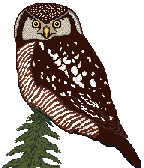

The Northern Hawk Owl (Surnia Ulula) like the Boreal Owl ranks as one of the most wanted bird species on most birders North American list. There are two other recognized subspecies of Hawk Owls in the world: the European Hawk Owl (Surnia Ulula Ulula )and the Siberian Hawk Owl (Surnia Ulula Pallasi ). In North America the Northern Hawk Owl breeding range extends from Newfoundland, West to Alaska and South through the extreme northern areas of the Great Lakes.
Northern Hawk Owls do not migrant but sometimes move South in search of food during the winter. A few hawk owls come south each year. These are mostly young birds. In years when the food supply runs low large numbers of hawk owls can be located in the U.S. In Michigan the most recent influx of Hawk Owls came during 1995-96. A much larger invasion of owls took place during 1991-92 when 27 hawk owls wintered in Michigan. Other states also recorded large Hawk Owl numbers that winter. For example Minnesota recorded 142 and Ontario 102. The reason for this irruptive nature has to do with the prey population in the North crashing. The most recent Hawk Owl invasion occurred in Minnesota during the winter of 2004-2005. The first owl appeared on October 4th. By the end of the season over 200 Hawk Owls were reported hunting in the state.
This owl is an active daytime hunter. Usually seen perched high on a telephone pole or tree while searching for prey. A Hawk Owl can resemble a raven from a distance. However unlike ravens Hawk Owls will often raise their tail and slowly lower it. Sometimes they will sit with their tail cocked. Hawk Owls will also patrol overhead and hover before striking its prey. Small rodents such as Voles are its favorite prey accounting for 90 percent of its summer diet. In the winter when food is scarce it will feed heavily on small birds. This very agile hunter can catch birds in mid-air.
In the winter Michigan host Hawk Owls in the Eastern portion of the Upper Peninsula near Sault Ste Marie pronounced(Sue Saint Marie). Hawk Owls have been recorded there 10 of the past 18 years. Birds start to move into their winter area as early as late September. More typically birds start to move down from October to early December. If you plan to go to Sault Ste Marie in search of this owl, check the Michigan bird hot lines to see if any owls have been located. During the winter Hawk Owls are site faithful. So where they have been seen is a good place to begin your search. A good place to start your search is South of Sault Ste Marie on the often snow covered roads. Look for Hawk Owls to be perched high on a telephone pole or the edge of a woodlot. Once located this owl can be easily approached.
Whitefish Point offers winter birding tours out of the Sault. This is a great way to increase your chances of locating this very trusting owl. It's also a chance to meet other birders from across the country. These trips are designed to last all day Saturday stopping only for lunch. On Sunday birding is optional with the group. Due to traveling conflicts many people choose to car-pool with fellow birders. Come prepared for cold weather. Winter at the Sault can be bitter.
Bird Hot line numbers for Michigan include:
- Detroit Audubon Society at 1-248-477-1360
- Sault Ste Marie Audubon Society at 1-705-256-2790
|Top of page1| |Top of page2| |Boreal Owl Page| |Northern Hawk-Owl photo| |HOME PAGE|
- Length: 14.3 to 17.6 inches (36.3 to 44.7 centimeters).
- Wingspread: 30.6 to 35.1 inches (77.7 to 89.1 centimeters).
- Flight style: Straight and swift usually very low. Often Falcon like with rapid erratic wingbeats.
- Voice: A series of whistles 10-15 groups per minute. Like a chattering kikikiki or a high pitched wita-wita-wita.
- Nesting: Natural cavities in trees such as old snags and pileated woodpecker holes. The nest is a simple depression. Sometimes dead grass, twigs, moss or down will be added. They will also use abandoned nest of larger birds like hawks or ravens in conifer trees.
- Eggs: 3 to 7 pure white. Incubation about 25-30 days.
- Fledging: Young grow quickly and fledge in 25-35 days. Fledglings are not fully on their own for about 3 months.
- Food: Small rodents like mice, voles, small birds and insects.
- Pellets: Small gray mucus-coated.
- Subspecies: There are 2 recognized subspecies of this owl in the world, only one of which is normally found in North America.
- Habitat: Tamarack swamp and boreal forest edges with a preference to area with dead trees. Also in areas of mixed hardwood forest.
- Distribution: In North America the range extends from Alaska and Canada southward to New England and the northern Great Lakes region. Sometimes venturing further south in the winter.